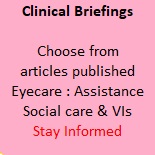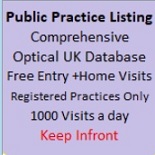Charities & Support Groups
Pioneering new visual function tool looks to revolutionise eyecare for people with learning disabilities
Pioneering new visual function tool looks to revolutionise eyecare for people with learning disabilities
SeeAbility are proud to announce the national launch of the Bradford Visual Function Box (BVFB) launched on Friday 5th November.
The Bradford Visual Function Box (BVFB) has been validated for use and results have been published in the British Journal of Ophthalmology.[1] It is designed to help provide real-life, contextualised information about visual function to parents, teachers, and carers of people with learning disability or special needs.
Eye care professionals can use the BVFB results to explain what the person is able to see around them, which allows parents and support staff supporting a child or adult with complex and severe learning disabilities difficulties to instantly ‘see what they see’.
SeeAbility Trustee Professor Rachel Pilling is the Consultant Paediatric Ophthalmologist at the Bradford Teaching Hospitals NHS Foundation Trust. Together with Caroline Rawse, an advanced Orthoptist, they have spent the last decade developing the tool, which looks to identify what someone sees, where they see and how they use their vision.

Professor Rachel Pilling said: “Adults with learning disabilities are 10 times more likely to have serious vision problems and for children this figure rises to 28 times more likely.
“Our experience of testing children and adults with complex needs is that it is difficult to engage them in traditional sight tests as they simply aren’t interesting enough or the largest size pictures big enough for some people to see. This sometimes means they can’t access the treatments or support they need. The BVFB was developed to fill this gap in assessments.”
Rachel Pilling has been a consultant paediatric ophthalmologist in Bradford since 2010. She qualified in Medicine in 2000 and underwent training in Leicester and West Yorkshire. Her first interaction with special needs eye care was as a high school student on work experience with Prof Gordon Dutton in Glasgow, from there a career-long fascination with helping people understand their vision began. She has published in many aspects of eye care for people with learning disability, including RCOphth and RCGP guidelines.
Rachel’s involvement with SeeAbility began in 2011, supporting their eye care public health campaigning and subsequently as a trustee in 2018.
The tool enables a flexible approach to testing in terms of environment, testing distance and visual attention. The assessments depend on observations and cues from people as they react to a variety of objects including small toys, colourful beads, and black and white books. Responses include blinking, pupils constricting, the eyes moving, smiling or vocalising and reaching out for the object.
The boxes come at a low cost of £40 + postage, to order a box see https://www.seeability.org/resources/bradford-visual-function-box and contact eyecare@seeability.org
Caroline Rawse said: “We believe that if we want to help people who have difficulty seeing, we must first be able to understand their functional vison – this is what they see, where they see and how they see it.
The BVFB was more than a decade in the making and is simple, quick, portable and adaptable for use with children and adults with a wide range of abilities.’
Matt Broom Strategic Lead for Eye Health and Vision at SeeAbility said: ‘We are so pleased to be launching this fabulous eyecare tool and hope it will make a really positive difference to the eye care of adults and children with complex and severe learning disabilitiesIt’s easy to use, offers both clinician and patient/carer a more rewarding experience and works toward what we have always said at SeeAbility – that no one is too disabled to have an eye test. Whether it’s living, thriving, belonging or loving, ultimately what we want is greater inclusion and being able to make the best use of your vision is key to this. We look forward to the Bradford Visual Function Box being used across the country and beyond.”
Further information about SeeAbility’s eye care work and resources, is available at www.seeability.org/eye-care
























